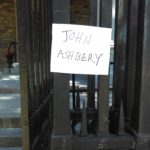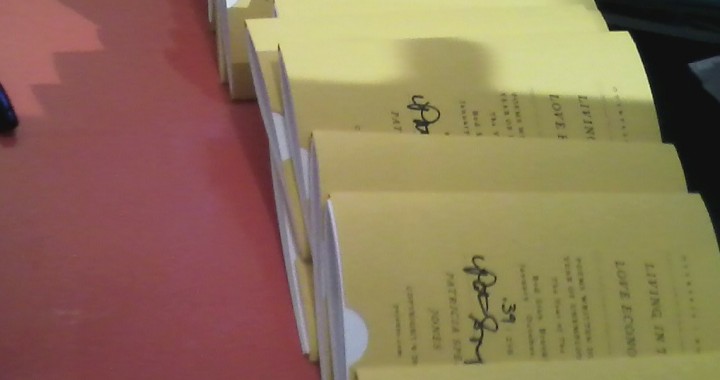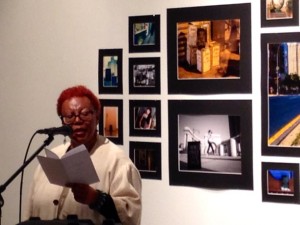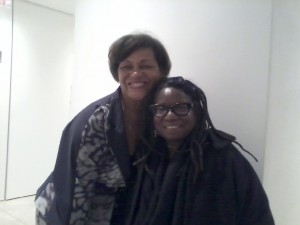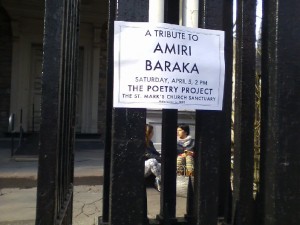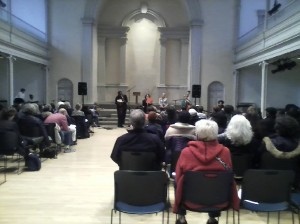It seems fitting to post this picture of a humble sign placed on the gates in front of St. Mark’s Church. Today’s morning sky was BRIGHT as in BRIGHT and the air a soft chill. Adam Fitzgerald, Emily Skillings, Eileen Myles and the staff at The Poetry Project organized an informal, intimate farewell in the church’s austere sanctuary. A place where John had sad many a time. The last time I went to an event like this was the one organized for Amiri Baraka, which I chronicled in an earlier post. Since it was early and I live in Brooklyn, I got there about half hour into the proceedings just in time to hear David Shapiro, shaking and frail, tell anecdote after anecdote, mostly it seemed about himself, but really about the relationship he had with Ashbery. He read a letter Ashbery sent to him when he was 15! He read a beautiful poem. He made me want to just sit him down. I did not cry. But I think Emily did as she played an audio of John reading from a recent poem–every once in a while he would cough, but then his voice would regain vigor–that performance thing that kicks in no matter what. I had not realized that Emily was one of Ashbery’s many assistants.
Marcella Durand talked about his inscriptions–they were often lines from specific poems in the books and she read the inscriptions and then the excerpts from the poems. Fred Moten told us he never met John, but had some words to say and so he said them–it was a fine salute. Dorothy Friedman talked about being part of Ashbery’s first class for the Brooklyn College MFA program back in 1974. Her voice boomed out and she noted that a week or so after Ashbery’s demise, she got a letter from him (the post office is really getting slow) thanking her for her review of his recent art show. Todd Colby also talked about that program, but by the time he got to Brooklyn John had left–that MacArthur grant made a huge difference.
I think that because John travelled, wore suits on occasion and was a most courtly of gentlemen poets, some folks thought him rich–he was not. He worked hard all his life and you could see the range of that work in the kinds of pieces poets used. Bob Holman talked about creating a performance script from Girls on the Run, Ashbery’s booklength poem based on the Henry Darger art work. And he read a fine tribute poem. Jeff Wright told a joke that John liked to tell. And Paul Muldoon read the final poem Ashbery published in The New Yorker.
I was going to read from The Vermont Notebooks, which is not the most sophisticated of Ashbery’s ouvre but maybe the most fun–it’s the collaboration with Joe Brainard. And there they are on the cover looking super masculine-lots of hair, work clothes oh so 70s! Oh before AIDS. Anyways, I left the book in my living room and well basically said I represented all the Black poets (Fred included) who really loved John’s work and also the ones who knew him. And I read my poem for John’s 90th birthday: “Le Tribute
Le Tribute
Funny you request 90 words for 90 years
Okay the thing about Ashbery
Is that he makes us
unsure of which direction is the direction home
But, there is always home in Ashbery’s work, now isn’ t there?
Home & fame’s odd wit.
John tells me about seeing Marlon Brando Boston tryout
in A Streetcar Named Desire. A new masculine norm.
The abstracted beauty of it all & odd tempered music
and the ears ready to hear.
That he has
Something to say
and will just
Say it. So there.
Then Adam Fitzgerald gave story and anecdote and quip and love in the form of stories, anecdotes, quips expressing his deep love for his mentor and friend. I did not hear John sing Old Man River–that might have been too much, but I got back for le restroom to hear Rachmaninoff-Ashbery’s favorite music. Tres romantic.
Walking out into the bright mid day–I knew that a mass murder took place in New Orleans, that our President seemed to have an inability to communicate with people who are not White, rich and male, that there are more people sleeping on subway benches and that the subways frequently breakdown and the sun will set and it will rise as we humans regard:
“The climate, the cities, the houses, the streets, the stores, the lights, people.” John Ashbery, The Vermont Notebooks.
He’s got many friends in Poetry Heaven–I bet the party has started.
